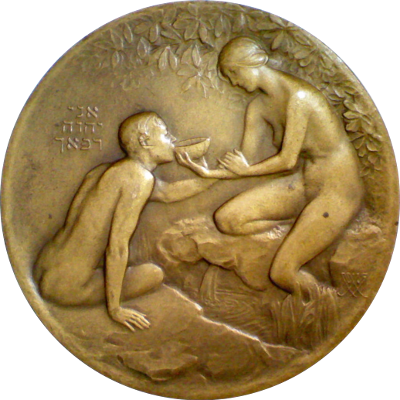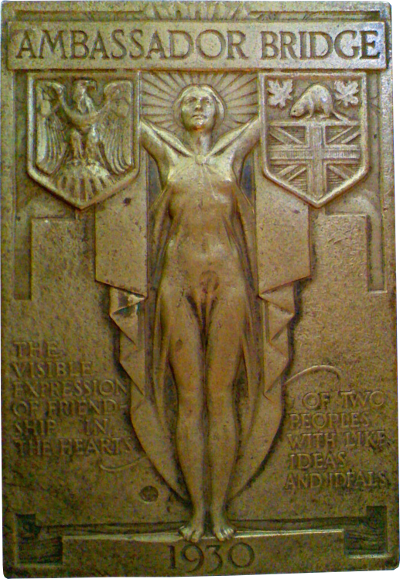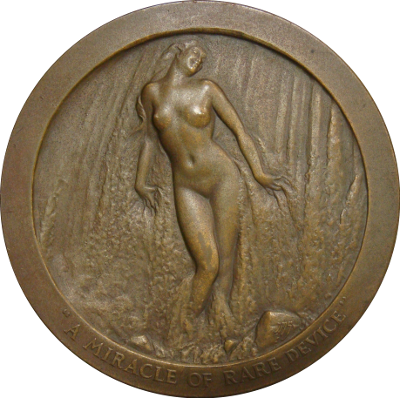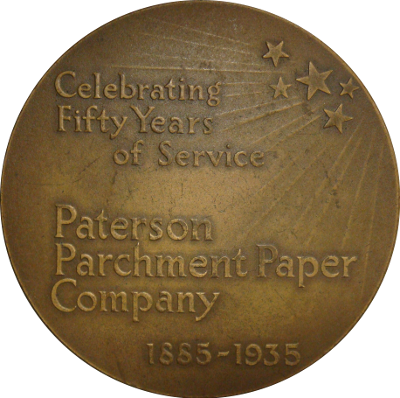Artist Name
You can click medals to switch between obverse and reverse sides.


The medal's obverse bears seated nude female at right holding a cup of water to seated nude male's mouth. At top left hebrew letters, at right, artist's signature (JMS monogram)
The reverse bears a view of the new hospital under star of David. In exergue, BETH ISRAEL HOSPITAL / NEWARK · NEW JERSEY / · FEBRUARY · 1928 ·
When Beth Israel was founded in 1901 it was located in a former residence on High Street. The hospital grew and prospered along with the Jewish community that supported it. Eventually a grand new building was raised on Lyons Avenue in the Weequahic section. This move confirmed that the Weequahic section had become the center of Jewish community life in Newark. The medal pictured along with this blog was made to mark the opening of the new hospital building.
This is a very beautiful and somewhat rare Swanson medal in Art Nouveau style. At least one large galvano is known to exist. The hebrew letters on the obverse spell an excerpt from the book of Exodus 15:25: "for I am the Lord that heals you."
The circular medal measures 75mm in diameter and was struck in bronze by the Medallic Art Company of New York. The mintage is not reported.


The paperweight's obverse bears a radiant maiden holding two shields, one with the American eagle perched on Stars and Stripes, one with Canadian beaver and maple leaves over Union Jack. Above, AMBASSADOR BRIDGE; to left, THE / VISIBLE / EXPRESSION / OF FRIEND-/ SHIP IN / THE HEARTS; to right, OF TWO / PEOPLES / WITH LIKE / IDEAS / AND IDEALS; signed near maiden's left foot with (JMS monogram) in circle; below, 1930.
The reverse bears the inscription COMPLIMENTS / OF / J W AUSTIN.
This paperweight commemorates the completion of the Ambassador Bridge across the Detroit River between Detroit on the U.S. side and Windsor on the Canadian side.
The bridge was a highly controversial, privately funded enterprise. John W. Austin and Joseph A. Bower came up with the idea and pushed it through over the vehement objections of Detroit mayor John Smith. A public referendum finally approved the project after a protracted political and legal battle. Construction began in 1927 and the bridge opened just three years later in 1930.
Jonathan Swanson created a beautiful plaque that decorates the bridge to this day and bridge financiers Austin and Bower had the paperweights produced as mementos.
The paperweight measures 70mm x 100mm and was produced by the Medallic Art Company of New York.


The obverse shows sensuous nude under waterfall. Below, "A MIRACLE OF RARE DEVICE"; signed at lower right, (JMS monogram).
The reverse bears five stars at upper right. Across, Celebrating / Fifty Years / of Service / Paterson / Parchment Paper / Company / 1885 - 1935.
The edge contains maker's mark at 6:00: MEDALLIC ART CO.N.Y.
The Paterson Parchment Paper Company was founded in 1885 in the city of Passaic, New Jersey. It flourished for several decades but in 1931 it found itself on the recieving end of a monopolization and price discrimination law suit brought by the Story Parchment Company. Apparently, this did not hurt the company all too much because by 1961 it was the World's largest manufacturer of vegetable parchment and custom made paper.
"A miracle of rare device" is a reference to Samuel Taylor Coleridge's Kubla Khan. The second stanza starts out with:
The shadow of the dome of pleasure
Floated midway on the waves;
Where was heard the mingled measure
From the fountain and the caves.
It was a miracle of rare device,
A sunny pleasure-dome with caves of ice!
A damsel with a dulcimer
In a vision once I saw;
It was an Abyssinian maid,
And on her dulcimer she played,
Singing of Mount Abora.
This is an unusual commercial medal because the nude on the medal's obverse is definitely sensuous if not overtly sexual in her posture. Normally, nude females were reserved for allegorical or mythical pictures and while the pictured nude might be a reference to the poem's Abyssinian maid (missing her dulcimer), it seems more likely that it is a reference to the pleasure-dome. I would love to know how this medal was received in the 1930's, not by the art world, but by Paterson's friends and customers.
The medal measures 76mm in diameter and was struck in bronze by the Medallic Art Company.